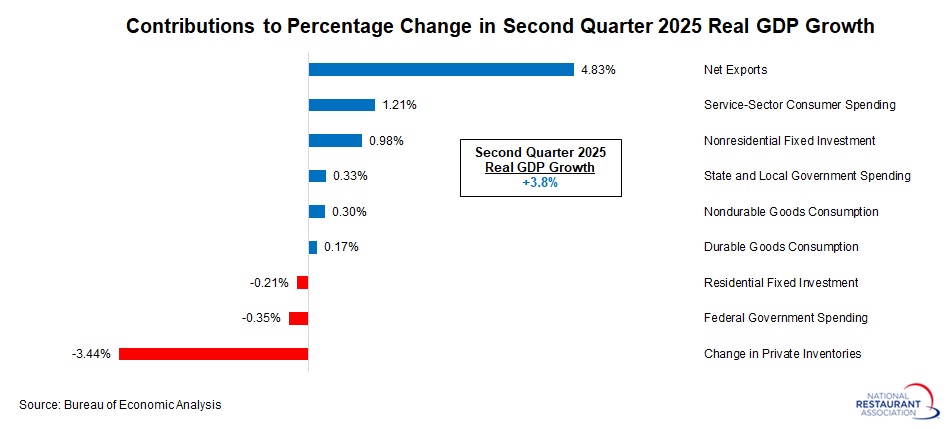Research
September 25, 2025
GDP
U.S. Economy Rebounded Strongly in Q2 Amid Spending Resilience
The U.S. economy expanded at a robust 3.8% annual rate in the second quarter of 2025, according to the latest revision—up from the previous estimate of 3.3% and stronger than anticipated. This marks a solid recovery following a 0.5% contraction in the first quarter.
Economic data from the first half of the year were notably volatile. A surge in imports and inventory accumulation in Q1—largely driven by efforts to get ahead of potential tariffs—was followed by a sharp correction in Q2. These swings contributed to “noisy” underlying trends and point to a broader transition toward a new normal in trade, as businesses and consumers adjust to persistent economic uncertainties.
Illustrating the economy’s resilience, real final sales to private domestic purchasers—a key measure of underlying demand that includes personal consumption and fixed investment—rose at a 2.9% annualized rate, the strongest pace since Q3 2024. This suggests steady but cautious domestic spending amid evolving conditions.
Looking ahead, the National Restaurant Association forecasts continued growth, with real GDP projected to rise by 1.9% annually in both 2025 and 2026. This outlook reflects ongoing momentum, even as downside risks remain.
A closer look at the second-quarter data reveals that consumer spending offered modest support to overall growth. Personal consumption expenditures rose at a 2.5% annualized rate, a notable improvement from the 0.6% gain in Q1. Spending on durable goods and services rebounded after prior declines, with foodservices and accommodations contributing 0.28 percentage points to GDP growth—signaling a recovery in discretionary spending.
Investment activity presented a mixed picture. Residential investment fell by 5.1%, marking the fourth decline in five quarters and highlighting ongoing challenges in the housing market. In contrast, nonresidential fixed investment rose by a strong 7.3%, driven by solid gains across key business sectors.
Finally, government spending made a marginally negative contribution to real GDP growth. Federal outlays subtracted 0.35 percentage points from headline growth for the second consecutive quarter, though this was nearly offset by a 0.33 percentage point positive contribution from state and local governments.
Economic data from the first half of the year were notably volatile. A surge in imports and inventory accumulation in Q1—largely driven by efforts to get ahead of potential tariffs—was followed by a sharp correction in Q2. These swings contributed to “noisy” underlying trends and point to a broader transition toward a new normal in trade, as businesses and consumers adjust to persistent economic uncertainties.
Illustrating the economy’s resilience, real final sales to private domestic purchasers—a key measure of underlying demand that includes personal consumption and fixed investment—rose at a 2.9% annualized rate, the strongest pace since Q3 2024. This suggests steady but cautious domestic spending amid evolving conditions.
Looking ahead, the National Restaurant Association forecasts continued growth, with real GDP projected to rise by 1.9% annually in both 2025 and 2026. This outlook reflects ongoing momentum, even as downside risks remain.

A closer look at the second-quarter data reveals that consumer spending offered modest support to overall growth. Personal consumption expenditures rose at a 2.5% annualized rate, a notable improvement from the 0.6% gain in Q1. Spending on durable goods and services rebounded after prior declines, with foodservices and accommodations contributing 0.28 percentage points to GDP growth—signaling a recovery in discretionary spending.
Investment activity presented a mixed picture. Residential investment fell by 5.1%, marking the fourth decline in five quarters and highlighting ongoing challenges in the housing market. In contrast, nonresidential fixed investment rose by a strong 7.3%, driven by solid gains across key business sectors.
- Business spending on equipment increased 7.3%, continuing a steady upward trend.
- Investment in intellectual property products surged 15.0%, underscoring the growing emphasis on innovation.
- However, spending on structures declined 7.5%, the third drop in four quarters, reflecting persistent weakness in commercial real estate.
Finally, government spending made a marginally negative contribution to real GDP growth. Federal outlays subtracted 0.35 percentage points from headline growth for the second consecutive quarter, though this was nearly offset by a 0.33 percentage point positive contribution from state and local governments.
.jpg?lang=en-US)